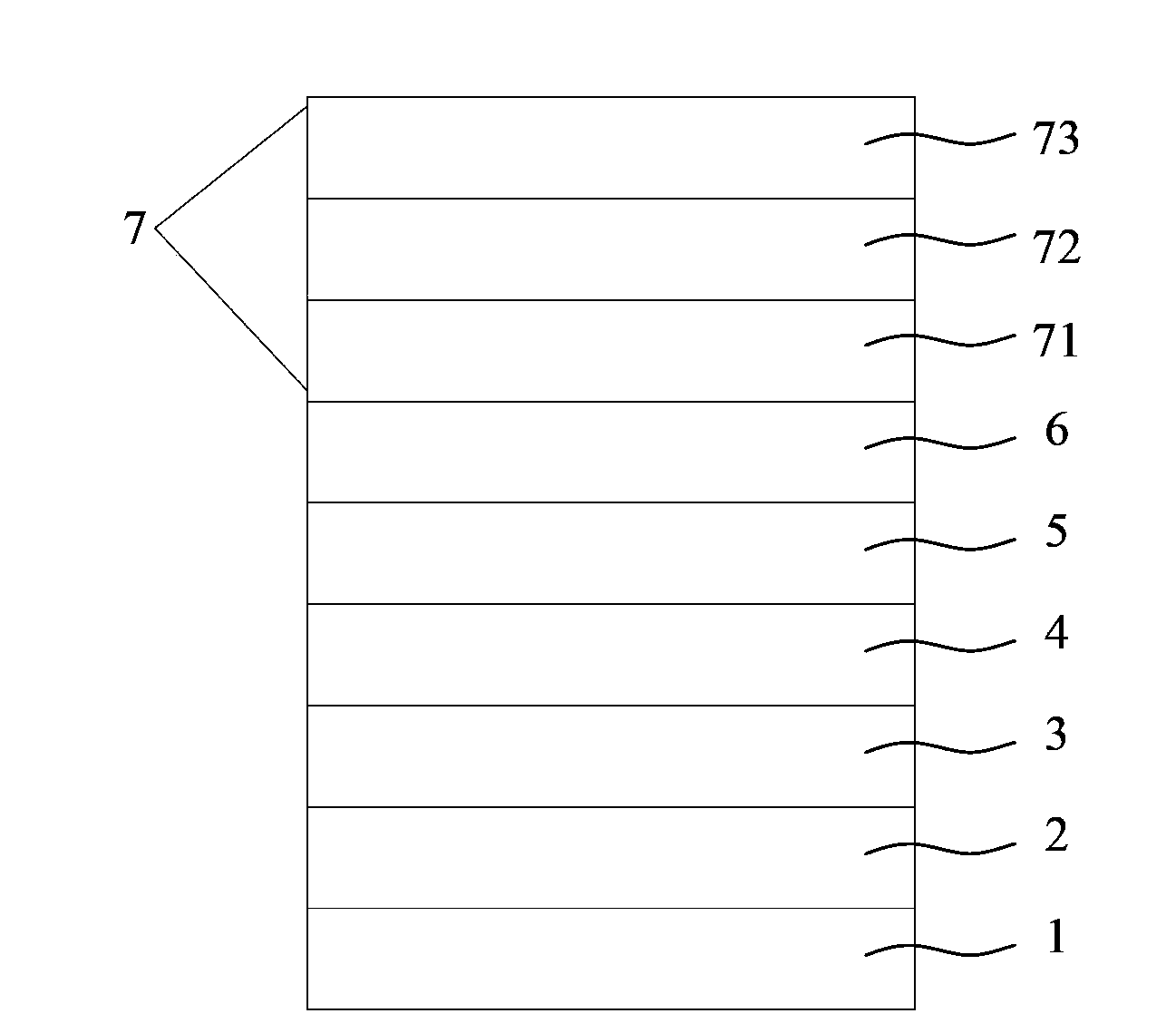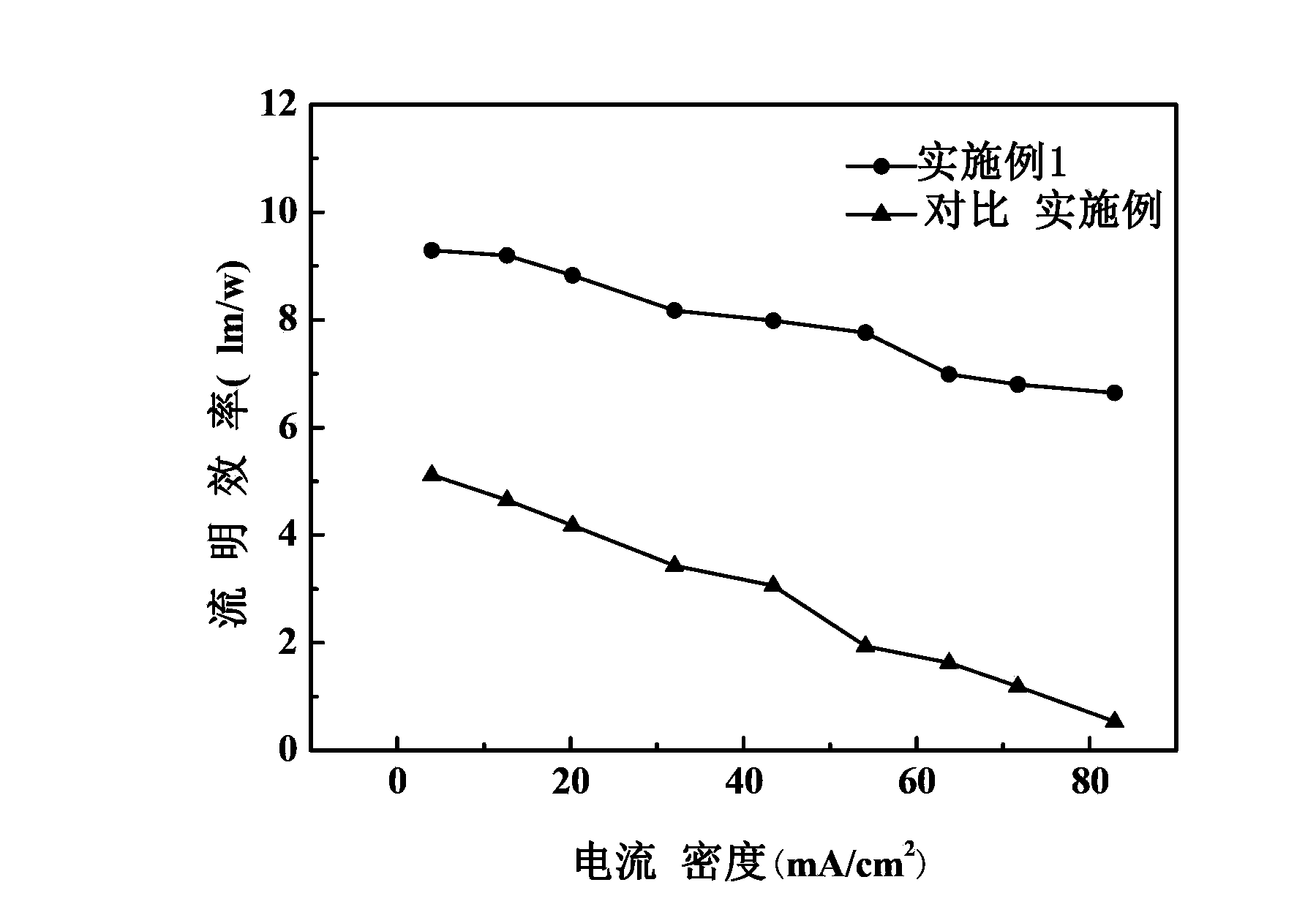Organic light-emitting device and preparation method thereof
An electroluminescent device and luminescent technology, which is applied in the direction of electric solid-state devices, semiconductor/solid-state device manufacturing, electrical components, etc., can solve the problems of poor refractive index, total reflection loss, low light extraction performance, etc., and achieve stable film layer, Reduce the injection barrier and improve the effect of outgoing light
- Summary
- Abstract
- Description
- Claims
- Application Information
AI Technical Summary
Problems solved by technology
Method used
Image
Examples
Embodiment 1
[0045] A method for preparing an organic electroluminescent device, comprising the following steps:
[0046] (1) First, the ITO glass substrate is subjected to photolithography treatment, and then cut into 2×2cm 2 Then use detergent, deionized water, acetone, ethanol, and isopropanol to ultrasonicate for 15 minutes each to remove organic pollutants on the glass surface, clean them and air dry them; then use thermal resistance evaporation on the anode Prepare hole injection layer, hole transport layer, light-emitting layer, electron transport layer and electron injection layer in sequence; Wherein,
[0047] The hole injection layer is made of MoO 3 , the pressure used in evaporation is 8×10 -5 Pa, the evaporation rate is 3nm / s, and the evaporation thickness is 25nm;
[0048] The material of the hole transport layer is NPB, and the pressure used during evaporation is 8×10 -5 Pa, the evaporation rate is 0.2nm / s, and the evaporation thickness is 45nm;
[0049] The material of...
Embodiment 2
[0059] A method for preparing an organic electroluminescent device, comprising the following steps:
[0060] (1) First, the AZO glass substrate is subjected to photolithography treatment, and then cut into 2×2cm 2 Then use detergent, deionized water, acetone, ethanol, and isopropanol to ultrasonicate for 15 minutes each to remove organic pollutants on the glass surface, clean them and air dry them; then use thermal resistance evaporation on the anode Prepare hole injection layer, hole transport layer, light-emitting layer, electron transport layer and electron injection layer in sequence; Wherein,
[0061] The material of the hole injection layer is WO 3 , the pressure used in evaporation is 2×10 -3 Pa, the evaporation rate is 10nm / s, and the evaporation thickness is 80nm;
[0062] The material of the hole transport layer is TCTA, and the pressure used during evaporation is 2×10 -3 Pa, the evaporation rate is 0.1nm / s, and the evaporation thickness is 60nm;
[0063] The ma...
Embodiment 3
[0073] A method for preparing an organic electroluminescent device, comprising the following steps:
[0074] (1) First, the IZO glass substrate is subjected to photolithography treatment, and then cut into 2×2cm 2 Then use detergent, deionized water, acetone, ethanol, and isopropanol to ultrasonicate for 15 minutes each to remove organic pollutants on the glass surface, clean them and air dry them; then use thermal resistance evaporation on the anode Prepare hole injection layer, hole transport layer, light-emitting layer, electron transport layer and electron injection layer in sequence; Wherein,
[0075] The material of the hole injection layer is V 2 o 5 , the pressure used in evaporation is 5×10 -5 Pa, the evaporation rate is 1nm / s, and the evaporation thickness is 20nm;
[0076] The material of the hole transport layer is TAPC, and the pressure used during evaporation is 5×10 -5 Pa, the evaporation rate is 1nm / s, and the evaporation thickness is 20nm;
[0077] The m...
PUM
| Property | Measurement | Unit |
|---|---|---|
| Work function | aaaaa | aaaaa |
| Thickness | aaaaa | aaaaa |
| Thickness | aaaaa | aaaaa |
Abstract
Description
Claims
Application Information
 Login to View More
Login to View More - R&D
- Intellectual Property
- Life Sciences
- Materials
- Tech Scout
- Unparalleled Data Quality
- Higher Quality Content
- 60% Fewer Hallucinations
Browse by: Latest US Patents, China's latest patents, Technical Efficacy Thesaurus, Application Domain, Technology Topic, Popular Technical Reports.
© 2025 PatSnap. All rights reserved.Legal|Privacy policy|Modern Slavery Act Transparency Statement|Sitemap|About US| Contact US: help@patsnap.com


